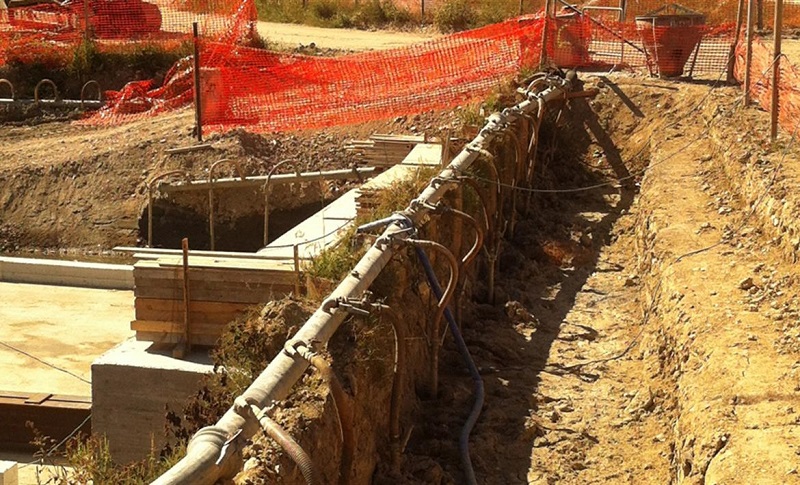Wellpoint
A wellpoint, also known as a drive point, is a small diameter well used for dewatering. It consists of a shallow shaft, a dewatering pump to draw water, a riser pipe which connects the wellpoint to the surface, and a small ‘well’ that fills up.
The riser pipes tend to be around 38-50 mm in diameter, with slots or openings at the bottom which enable water to be drawn up using the pump. The size of the openings is determined by the relative grain size of the water-bearing formation material. The openings should be large enough to allow water to enter the tube, but small enough to keep the water-bearing formation in place.
The riser pipe is often connected to a common header main pipe through a flexbow. This flexbow incorporates an adjustable valve which serves two purposes: firstly, it controls the flow of air and water entering the system; and secondly, allows a clear view of what is being pumped. The header main pipe is then connected to a wellpoint dewatering pump.
Wellpoints are fairly versatile and can be used for a wide range of applications. They are suitable for shallow foundations and trench works, particularly for long pipeline trenches where wellpoints may be installed in parallel by special trenching machines.
They can also be used for the irrigation of small to medium-sized residential gardens. If the water yield from one well is not sufficient for running an irrigation system, a second can be installed and connected to the first, enabling them to operate as one system.
They can also be used around the perimeter of excavations as an alternative to boreholes, as a means of lowering and controlling groundwater levels. They can be more cost- and time-efficient than a borehole due to the shallower depths required. In appropriate ground conditions, a wellpoint system can be installed very quickly. Traditional drilling techniques, such as jetting or auguring are typically used for installation.
Wellpoints tend not to yield large quantities of water – around 5 gallons per minute is typical. There is generally a limit of about 5-6 m in height over which water can be drawn as the vacuum is limited in practice to 0 bar. However, a second stage of wellpoints can be installed at a lower level if greater depths are required. They are capable of dealing with very low flows in silty sands as well as much larger flows in coarse sands and gravel.
Some of the benefits of using wellpoints include:
- Quick installation in most ground conditions.
- Easy to maintain.
- Capable of being used for both large and small-scale projects.
- Self-jetting wellpoints can be used in situations where there is limited space.
[edit] Find out more
[edit] Related articles on Designing Buildings Wiki
Featured articles and news
Amendment to the GB Energy Bill welcomed by ECA
Move prevents nationally-owned energy company from investing in solar panels produced by modern slavery.
Gregor Harvie argues that AI is state-sanctioned theft of IP.
Heat pumps, vehicle chargers and heating appliances must be sold with smart functionality.
Experimental AI housing target help for councils
Experimental AI could help councils meet housing targets by digitising records.
New-style degrees set for reformed ARB accreditation
Following the ARB Tomorrow's Architects competency outcomes for Architects.
BSRIA Occupant Wellbeing survey BOW
Occupant satisfaction and wellbeing tool inc. physical environment, indoor facilities, functionality and accessibility.
Preserving, waterproofing and decorating buildings.
Many resources for visitors aswell as new features for members.
Using technology to empower communities
The Community data platform; capturing the DNA of a place and fostering participation, for better design.
Heat pump and wind turbine sound calculations for PDRs
MCS publish updated sound calculation standards for permitted development installations.
Homes England creates largest housing-led site in the North
Successful, 34 hectare land acquisition with the residential allocation now completed.
Scottish apprenticeship training proposals
General support although better accountability and transparency is sought.
The history of building regulations
A story of belated action in response to crisis.
Moisture, fire safety and emerging trends in living walls
How wet is your wall?
Current policy explained and newly published consultation by the UK and Welsh Governments.
British architecture 1919–39. Book review.
Conservation of listed prefabs in Moseley.
Energy industry calls for urgent reform.


























Comments